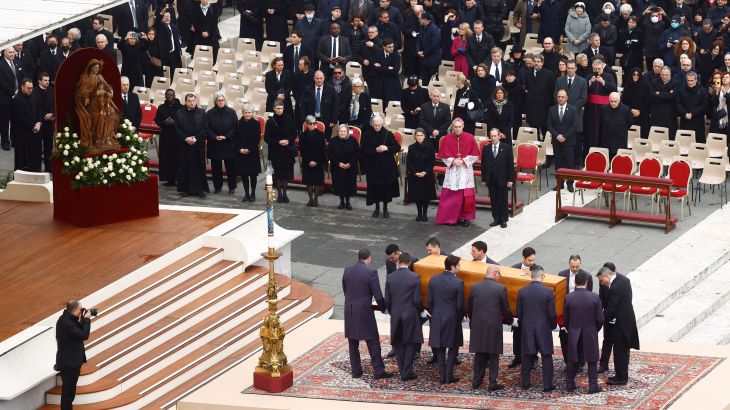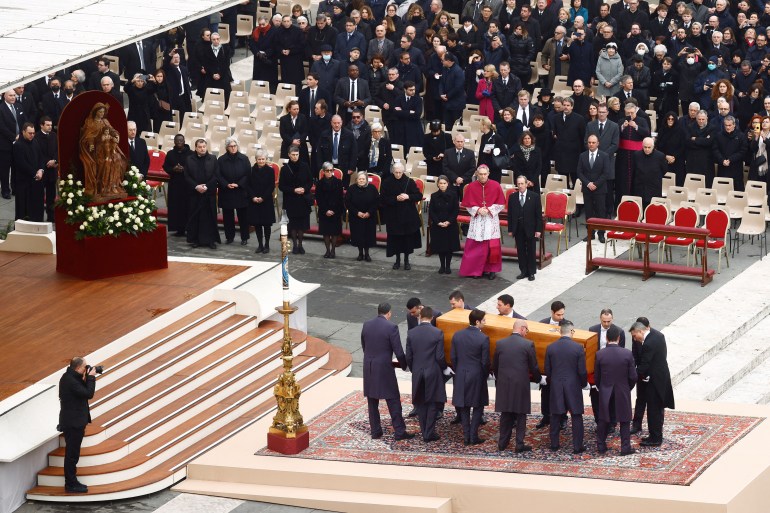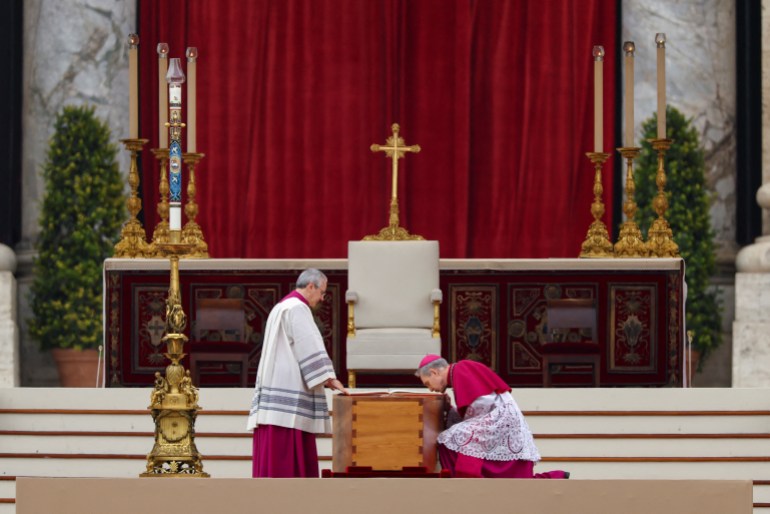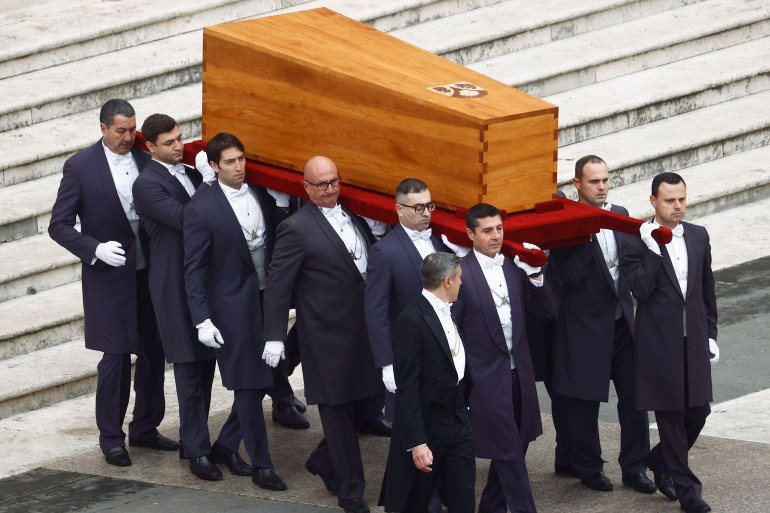Benedict XVI, the German pope who made history, laid to rest
Mourners gather at the Vatican to pay their final respects to German theologian Pope Emeritus Benedict XVI.

Mourners poured into Saint Peter’s Square for the funeral of Pope Emeritus Benedict XVI to pay their final respects to the German theologian and attend a rare requiem mass for a dead pontiff presided over by a living one.
Bells tolled on Thursday and the crowd applauded as pallbearers carried Benedict’s cypress coffin out of the basilica and rested it before the altar in the piazza, as red-robed cardinals looked on.
Keep reading
list of 4 itemsPope Francis, world leaders pay tribute to Benedict XVI
Photos: The life of Pope Emeritus Benedict XVI
Obituary: Pope Emeritus Benedict XVI, pontiff who resigned
Heads of state and royalty, clergy from around the world and thousands of worshippers flocked to the Vatican, despite Benedict’s requests for simplicity and official efforts to keep the first funeral of a pope emeritus in modern times low-key.
Many mourners hailed from Benedict’s native Bavaria and donned traditional dress, including boiled wool coats to guard against the morning chill.
“We came to pay homage to Benedict and wanted to be here today to say goodbye,” said Raymond Mainar, who travelled from a small village east of Munich for the funeral. “He was a very good pope.”

The former Joseph Ratzinger, who died on December 31 at age 95, is considered one of the 20th century’s greatest theologians and spent his lifetime upholding church doctrine.
But he will go down in history for a singular, revolutionary act that changed the future of the papacy: he retired, the first pope in six centuries to do so.
Pope Francis has praised Benedict’s courage to step aside, saying it “opened the door” to other popes doing the same. Francis, for his part, recently said he has already left written instructions outlining the conditions in which he, too, would resign.
Francis presided over the funeral.
Only Italy and Germany were invited to send official delegations, but other heads of state and government took the Vatican up on its offer and came in their “private capacity”. They included several other heads of state, at least four prime ministers and two delegations of royal representatives.

Early on Thursday the Vatican released the official history of Benedict’s life, a short document in Latin that was placed in a metal cylinder in his coffin before it was sealed, along with the coins and medallions minted during his papacy and his pallium stoles.
The document gave ample attention to Benedict’s historic resignation and referred to him as “pope emeritus,” citing verbatim the Latin words he uttered on February 11, 2013, when he announced he would retire.
The document, known as a “rogito” or deed, also cited his theological and papal legacy, including his outreach to Anglicans and Jews, and his efforts to combat clergy sexual abuse “continually calling the church to conversion, prayer, penance and purification”.
Benedict’s close confidants were also in attendance, and the former pope’s longtime secretary, Archbishop Georg Gaenswein, bent down and kissed a book of the gospels that was left open on the coffin before the ceremony began.
Matteo Colonna, a 20-year-old seminarian from Teramo, Italy, said he came in part because of the historic nature of the funeral – but also because it had personal resonance for him.
“The first spark of my vocation started under the pontificate of Benedict, but then it became even stronger under Pope Francis,” Colonna said, while sitting in prayer in St Peter’s Square at dawn.
“I see a continuity between these two popes and the fact that today, Francis is celebrating the funeral in Benedict’s memory is an historical event.”
Ratzinger’s legacy
During St John Paul II’s quarter-century as pope, Ratzinger spearheaded a crackdown on dissent as prefect of the Congregation for the Doctrine of the Faith, taking action against the left-leaning liberation theology that spread in Latin America in the 1970s and against dissenting theologians and nuns who did not toe the Vatican’s hard line on matters like sexual morals.
His legacy was marred by the clergy sexual abuse scandal, even though he recognised earlier than most the “filth” of priests who raped children, and actually laid the groundwork for the Holy See to punish them.
As cardinal and pope, he passed sweeping church legislation that resulted in 848 priests being defrocked from 2004 to 2014, roughly his pontificate with a year on either end.
But abuse survivors still held him responsible for the crisis, for failing to sanction any bishop who moved abusers around, refusing to mandate the reporting of sex crimes to police and identifying him as embodying the clerical system that long protected the institution over victims.
Mike McDonnell of the US abuse survivor group SNAP said while Benedict passed new canon laws, he could have done far more to influence John Paul to take firm action. Referring to Benedict’s nickname as “God’s Rottweiler,’” he said: “You know, in our view, it was a dog bark without a bite. Certainly, he could have done more.”
A group representing German clergy abuse survivors called on German officials attending Benedict’s funeral to demand more action from the Vatican on sexual abuse. Eckiger Tisch asked German leaders to demand that Francis issue a “universal church law” stipulating zero tolerance in dealing with abuse by clergy.
The funeral ritual itself was modelled on the code used for dead popes but with some modifications, given Benedict was not a reigning pontiff when he died.
After the mass, Benedict’s cypress coffin was placed inside a zinc one, then an outer oak casket before being entombed in the crypt in the grottoes underneath St Peter’s Basilica that once held the tomb of St John Paul II before it was moved upstairs.
While Thursday’s mass was unusual, it does have some precedent: In 1802, Pope Pius VII presided over the funeral in St Peter’s of his predecessor, Pius VI, who had died in exile in France in 1799 as a prisoner of Napoleon.
